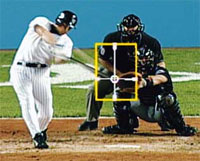 As the Phillies prepare to make another run at the World Series, TVs throughout the Delaware Valley will no doubt be tuning in to follow along. One thing viewers can expect to see shortly after a close pitch to the plate is an animated graphic depicting the strike zone and if the given pitch was ‘in fact’ a ball or a strike. The Emmy Award winning system known as KZone was first developed for ESPN in 2001 by Sportsvision Inc., it is now used by numerous other networks as well.
As the Phillies prepare to make another run at the World Series, TVs throughout the Delaware Valley will no doubt be tuning in to follow along. One thing viewers can expect to see shortly after a close pitch to the plate is an animated graphic depicting the strike zone and if the given pitch was ‘in fact’ a ball or a strike. The Emmy Award winning system known as KZone was first developed for ESPN in 2001 by Sportsvision Inc., it is now used by numerous other networks as well.
The technology behind the system is actually quite complex. Due to varying heights and batting stances of players, the strike zone is not the same for every batter. As a player places his front foot down in the batter’s box to take his stance, a KZone technician ‘sets’ the strike zone based on his position in the box and his height. Special ‘sensor’ cameras are mounted in center field, high above home plate, and down the first and third base lines. These cameras, which are not used for video broadcasting purposes, track the pitch as it crosses over the plate. The data from the cameras is sent to four computers running a sophisticated algorithm which compares the pre-set strike zone and the location of each pitch. This data is then used to generate the three dimensional image which we see on television. Sportsvision claims that the system is accurate to within 2/5ths of an inch.
Currently the system is used only for entertainment purposes. Both baseball officials and purists agree that computers will not replace the human umpires anytime soon. As professional sports integrate technology into officiating more and more, one can only wonder if it is simply a matter of time before fans at home will be yelling at KZone and not the man in blue.
4 Comments